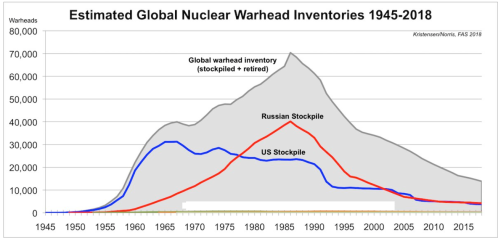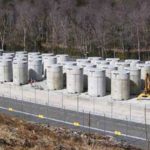At a political rally on Saturday 20 October President Trump announced that the US will withdraw from the Intermediate Nuclear Forces (INF) Treaty of 1987. This confirms what has steadily unfolded over the last couple of years: the architecture of US-Russian nuclear arms control is crumbling.
Building blocks of arms control
As the Cold War ended, four new building blocks of east-west arms control were laid on top of foundations set by the Anti-Ballistic Missile (ABM) Treaty of 1972:
- The 1987 INF Treaty eliminated all ground-launched missiles with a range between 500 and 5,500 kilometres, including both cruise and ballistic missiles.
- The 1991 Strategic Arms Reduction Treaty (START) reduced the numbers of strategic nuclear weapons; further cuts were agreed in 2002 and again in 2010 in the New START agreement.
- The 1990 Treaty on Conventional Forces in Europe (CFE Treaty) capped at equal levels the number of heavy weapons deployed between the Atlantic and the Urals by the then-members of both the North Atlantic Treaty Organization (NATO) and the Warsaw Treaty Organization (WTO).
- The 1991 Presidential Nuclear Initiatives (PNIs) were parallel, unilateral but agreed actions by both the US and the USSR to eliminate short-range tactical nuclear weapons, of which thousands existed.
Taken together, the nuclear measures – the INF Treaty, START and PNIs – had a major impact, as this graph from the Federation of American Scientists shows:

The fastest pace of reduction was in the 1990s. A deceleration began just before the new century started, and there has been a further easing of the pace in the last six years. But year by year, the number continues to fall. By the start of 2018 the global total of nuclear weapons was 14,700 compared to an all-time high of some 70,000 in the mid-1980s. Nuclear weapons are more capable in many ways than before; the reduction is, nonetheless, both large and significant.
Cracks appear: charge and counter-charge
Even while the numbers continued to drop, problems were emerging. Not least, in 2002 the US unilaterally withdrew from the ABM Treaty. That did not stop the US and Russia signing the Strategic Offensive Reductions Treaty in 2002 or New START in 2010 but perhaps it presaged later developments.
Trump’s announcement brings towards its conclusion a process that has been going on for several years. The US declared Russia to be violating the Treaty in July 2014. That, of course, was during the Obama administration. The allegation that Russia has breached the INF Treaty, in other words, is not new. This year the USA’s NATO allies also aligned themselves with the US accusation, albeit somewhat guardedly (cf the careful wording in paragraph 46 of the July Summit Declaration).
The charge is that Russia has developed a ground-launched cruise missile with a range over 500 kilometres. Many details have not been clearly stated publicly but it seems Russia may have modified a sea-launched missile (the Kalibr) and combined it with a mobile ground-based launcher (the Iskander K system). The modified system is known sometimes as the 9M729, or the SSC-8, or the SSC-X-8.
Russia rejects the US accusation. It makes the counter-charge that the US has itself violated the Treaty in three ways: first by using missiles banned under the Treaty for target practice; second because some US drones are effectively cruise missiles; and third because it has taken a maritime missile defence system and based it on land (Aegis Ashore) although its launch tubes could, the Russians say, be used for intermediate range missiles. Naturally, the US rejects these charges.
A further Russian criticism of the US over the INF Treaty is that, if the US wanted to discuss alleged non-compliance, it should have used the Treaty’s Special Verification Commission before going public. This was designed specifically to address questions about each side’s compliance. It did not meet between 2003 and November 2016; it was during that 13-year interval that US concerns about Russian cruise missiles arose.
Now Trump seems to have closed the argument by announcing withdrawal. Under Article XV of the Treaty, withdrawal can happen after six months’ notice. Unless there is a timely change of approach by either side or both, the Treaty looks likely to be a dead letter by April 2019.
It could be, however, that the announcement is intended as a manoeuvre to get concessions from the Russian side on the alleged missile deployment or on other aspects of an increasingly tense US-Russian relationship. That is what Russian deputy foreign minister, Sergei Ryabkov, implied by calling it “blackmail”.
Arms control in trouble
Whether the imminence of the INF Treaty’s demise is more apparent than real, its plight is part of a bigger picture. Arms control is in deep trouble. As well as the US abrogation of the ABM Treaty in 2002,
- Russia effectively withdrew from the CFE Treaty in 2015 arguing that the equal cap was no longer fair when five former Warsaw Pact states had joined NATO.
- The 2010 New START agreement on strategic nuclear arms lasts until 2021 and there are currently no talks about prolonging or replacing it.
- Russia claims that the US is technically violating New START because some launchers have been converted to non-nuclear use in a way that is not visible to Russia so it cannot verify them in the way the Treaty says it must be able to. The Russian government’s position is that until this is resolved, it is not possible to start work on the prolongation of New START, despite its imminent expiry date.
It seems likely that the precarious situation of US-Russian arms control will simultaneously put increasing pressure on the overall nuclear non-proliferation regime – a topic to which I will return in my next post – and sharpen the arguments about the Treaty on the Prohibition of Nuclear Weapons. For the advocates of what is often known as the nuclear ban, the erosion of arms control reinforces the case for moving forward to a world without nuclear weapons. For its opponents, the erosion of arms control shows the world is not at all ready for or capable of a nuclear ban.
The risk of a return to nuclear weapons build-ups by both Russia and the US is visible. We risk losing the degree of safety we gained with the end of the Cold War and have enjoyed since then. With US National Security Advisor John Bolton in Moscow as I write, and more importantly with the well-earned reputation for springing surprises that the US and Russian Presidents both have, there may be more developments in one direction or another in the coming days or weeks.


